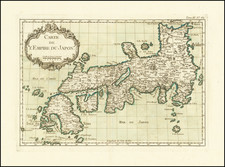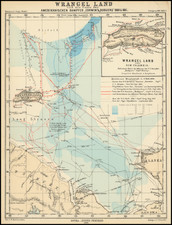Fine example of Goos' chart of the Japan, Korea, China and Northeastern Russia (Tartary), based on the limited knowledge of the mid 17th century.
The coastlines shown by Goos are almost completely speculative. Following the Vries voyage of 1643 the southeast coast of Hokkaido (Eso) has been mapped, as well as the southernmost of the Kuril Islands. There is great uncertainty regarding the size of Compagnies Land (Urup), which is here left incomplete but in later maps shown to stretch across the Pacific to North America.
Ships navigate the seas around the Siberian, Chinese and Japanese coast extending as far west as Nova Zembla, the chart continues eastwards to include Xantung province and Korea, mainland Japan and the land mass to the north 'Land van Eso' (Kamchatka). Eastwards the mysterious Compagnies Land is shown.
The chart appeared in what must certainly have been a deluxe edition of Goos' Nieuwe Groote Zee-Spiegel, one of the earliest modern sea atlases. The cartouches and other decorative elements are beautifully colored and highlighted with gold. On double paper, as issued.
Pieter Goos (ca. 1616-1675) was a Dutch map and chart maker, whose father, Abraham Goos (approx. 1590-1643), had already published numerous globes, land and sea maps together with Jodocus Hondius and Johannes Janssonius in Antwerp. Pieter gained recognition due to the publication of sea charts. He bought the copperplates of the famous guide book for sailors, De Lichtende Columne ofte Zeespiegel (Amsterdam 1644, 1649, 1650), from Anthonie Jacobsz. Goos published his own editions of this work in various languages, while adding his own maps. In 1666, he published his De Zee-Atlas ofte Water-Wereld, which is considered one of the best sea atlases of its time. Goos' sea charts came to dominate the Dutch market until the 1670s, when the Van Keulen family came to prominence.










![[ Guangzhou / Canton ] Map of the City and Entire Suburbs of Canton. Made By Rev. D. Vrooman. 1855.](https://storage.googleapis.com/raremaps/img/small/62631.jpg)

![[ China ] Carte vom Reich China nach der neuesten grossen Carte des Herrn. d'Anville und Hase entworfen 1762](https://storage.googleapis.com/raremaps/img/small/103353.jpg)
![(Central Asia and Russia) Tabula Asiae VII [Seventh Map of Asia]](https://storage.googleapis.com/raremaps/img/small/94381.jpg)
![[Hubei, China] Province De Hou-Quang](https://storage.googleapis.com/raremaps/img/small/95546.jpg)